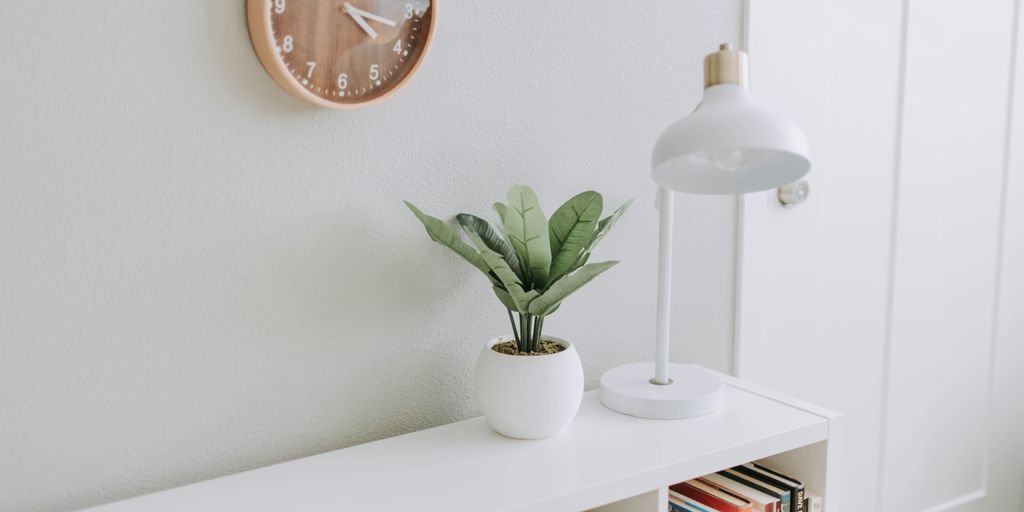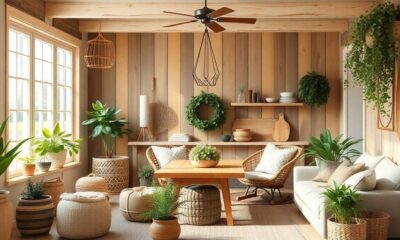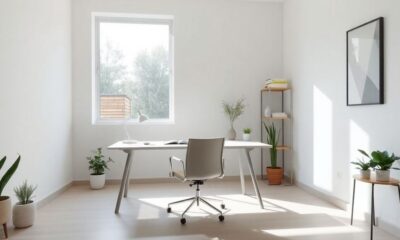Art & Culture
How to Use Plants as Decor in Every Room

Plants can transform any room into a lively and inviting space. They not only add beauty but also improve air quality and create a calming atmosphere. This guide will help you choose the right plants and use them effectively in every room of your home, ensuring you enjoy the benefits of greenery throughout your living space.
Key Takeaways
- Select plants that fit your home’s lighting and space needs.
- Use a mix of plant types to create visual interest in your decor.
- Incorporate plants into furniture arrangements for a cohesive look.
- Choose low-maintenance plants to simplify care while enhancing beauty.
- Use plants to brighten unused corners and make your space more inviting.
Choosing the Right Plants for Your Home
When it comes to decorating with plants, selecting the right varieties is essential. Here are some key points to consider:
Assessing Light and Space Requirements
- Understand the light conditions in your home. Some plants thrive in bright light, while others prefer shade.
- Measure the space where you plan to place your plants to ensure they have enough room to grow.
- Consider the temperature fluctuations in different areas of your home, especially near windows or doors.
Selecting Low-Maintenance Varieties
- For beginners, choose plants that are easy to care for, such as:
- Snake Plant
- Spider Plant
- Pothos
- These plants are not only resilient but also add a touch of greenery without much effort.
- Low-maintenance plants can help you enjoy the beauty of nature without the stress of constant care.
Matching Plants to Your Decor Style
- Think about the overall style of your home. For a modern look, opt for sleek pots in neutral colours.
- Rustic styles can benefit from wicker or wooden containers.
- Group plants with similar styles or colours for a cohesive look.
Remember, the right plants can transform your space, making it feel more inviting and lively.
By carefully considering these factors, you can create a beautiful and harmonious environment in your home.
Using Plants to Enhance Your Living Room
Plants can truly transform your living room into a vibrant and inviting space. Adding greenery not only beautifies your home but also improves air quality. Here are some effective ways to incorporate plants into your living room decor:
Creating a Focal Point with Large Plants
- Choose a statement plant like a Ficus tree or a Swiss Cheese plant to draw attention.
- Position it in a corner or near a window to maximise its impact.
- Consider using a stylish pot that complements your decor.
Incorporating Hanging Plants
- Use hanging planters to save space and add dimension.
- Plants like Pothos or Spider plants work well in hanging arrangements.
- Hang them at varying heights for a dynamic look.
Mixing Different Plant Types for Visual Interest
- Combine plants with different leaf shapes and sizes for a more engaging display.
- Use a mix of tall, medium, and small plants to create layers.
- Consider adding some flowering plants for a splash of colour.
By thoughtfully arranging plants, you can create a lively atmosphere that feels both fresh and welcoming.
Summary Table of Recommended Plants
| Plant Type | Light Requirement | Maintenance Level |
|---|---|---|
| Ficus Tree | Bright, indirect | Moderate |
| Swiss Cheese Plant | Bright, indirect | Low |
| Pothos | Low to bright | Very low |
| Spider Plant | Low to bright | Low |
| Areca Palm | Bright, indirect | Moderate |
Incorporating plants into your living room decor can create a warm and inviting environment, making it a perfect place to relax and entertain guests.
Decorating Your Kitchen with Plants
Bringing plants into your kitchen can create a lively and inviting atmosphere. Plants not only beautify the space but can also be functional. Here are some ideas to help you incorporate greenery into your kitchen decor:
Choosing Edible Plants for the Kitchen
- Herbs: Basil, parsley, and mint are great choices for fresh flavours in your cooking.
- Vegetables: Consider growing small vegetables like cherry tomatoes or peppers in pots.
- Fruits: Strawberries can thrive in hanging baskets, adding both beauty and taste.
Using Windowsills for Herb Gardens
- Sunlight: Place pots on windowsills where they can receive plenty of sunlight.
- Containers: Use small pots or jars to create a mini herb garden.
- Accessibility: Keep herbs close to your cooking area for easy access while preparing meals.
Incorporating Plants into Kitchen Shelving
- Layering: Use different heights of plants on shelves to create visual interest.
- Mixing: Combine plants with cookbooks and decorative items for a cohesive look.
- Grouping: Group plants of similar styles or colours together for a unified display.
Adding plants to your kitchen can transform it into a vibrant space, making cooking more enjoyable and inviting for guests.
By following these tips, you can easily enhance your kitchen with plants that are both beautiful and practical, making your cooking space feel more alive and welcoming.
Adding Greenery to Your Bathroom
Bringing plants into your bathroom can create a refreshing and calming atmosphere. Plants not only beautify the space but also improve air quality. Here are some tips to help you incorporate greenery effectively:
Selecting Humidity-Loving Plants
- Ferns: Thrive in humid conditions and add a lush look.
- Orchids: Elegant flowers that enjoy moisture.
- Bamboo: A hardy plant that can grow in low light.
Using Plants to Create a Spa-Like Atmosphere
- Arrange plants around your bathtub or shower for a relaxing vibe.
- Use larger plants like fiddle leaf figs to make a statement.
- Consider hanging plants to save space and add dimension.
Placing Plants on Shelves and Ledges
- Use shelves to display smaller pots, creating a mini garden.
- Group plants of varying heights for visual interest.
- Pegboards can be a creative way to showcase multiple plants in a compact area.
Adding plants to your bathroom can transform it into a serene retreat, making your daily routine feel more luxurious.
By choosing the right plants and arranging them thoughtfully, you can turn your bathroom into a green oasis that feels inviting and refreshing. Remember, the key is to select plants that thrive in the unique conditions of your bathroom, ensuring they flourish and enhance your space.
Incorporating Plants into Your Bedroom Decor
Choosing Calming Plants for Better Sleep
When selecting plants for your bedroom, opt for varieties that promote relaxation and improve air quality. Some excellent choices include:
- Lavender: Known for its calming scent.
- Snake Plant: Releases oxygen at night, aiding sleep.
- Peace Lily: Helps purify the air and is easy to care for.
Using Plants to Purify the Air
Plants can significantly enhance the air quality in your bedroom. Here are some effective air-purifying plants:
- Spider Plant: Great for removing toxins.
- Aloe Vera: Not only purifies but also has healing properties.
- Boston Fern: Excellent for humidifying the air.
Arranging Plants on Nightstands and Dressers
To create a serene atmosphere, consider these tips for placing plants:
- Use small pots on nightstands for a subtle touch.
- Group plants of varying heights on dressers for visual interest.
- Hang trailing plants from shelves to add dimension without taking up space.
Incorporating plants into your bedroom decor not only beautifies the space but also contributes to a healthier environment. A few well-placed plants can transform your room into a peaceful retreat.
Transforming Your Home Office with Plants
Adding plants to your home office can significantly improve your workspace. Plants not only beautify the area but also boost your mood and productivity. Here are some effective ways to incorporate greenery into your office:
Selecting Space-Saving Plants for Desks
- Succulents: These small plants require minimal care and fit perfectly on desks.
- Air Plants: They don’t need soil and can be placed in creative holders.
- Pothos: This trailing plant can be hung or placed on shelves, saving desk space.
Using Plants to Boost Creativity and Productivity
- Fiddle Leaf Fig: Known for its large leaves, it can create a vibrant atmosphere.
- Snake Plant: This hardy plant purifies the air, helping you focus better.
- Peace Lily: It not only looks good but also helps in reducing stress levels.
Arranging Plants on Shelves and Bookcases
- Mix Heights: Use plants of varying heights to create visual interest.
- Group Plants: Cluster plants together for a lush look.
- Use Decorative Pots: Choose pots that match your office decor for a cohesive look.
Incorporating plants into your workspace can transform it into a more inviting and productive environment. Start with a few and gradually expand your collection to create a green oasis in your office.
By following these tips, you can easily create a workspace that is not only functional but also filled with life and energy. Enjoy the process of selecting and caring for your plants!
Using Plants to Decorate Your Dining Room
Creating Centrepieces with Plants
Plants can make stunning centrepieces for your dining table. Consider using a mix of heights and textures to create visual interest. Here are some ideas:
- Use a large potted plant as a focal point.
- Combine smaller plants in decorative pots for a layered look.
- Incorporate seasonal flowers for a fresh touch.
Using Plants for Special Occasions
Plants can enhance the atmosphere during special gatherings. Here are some tips:
- Choose plants that match the theme of your event.
- Use plants as unique party favours for guests.
- Create a festive table setting by mixing plants with candles and decorations.
Incorporating Plants into Dining Room Furniture
Plants can be integrated into your dining room furniture for a cohesive look. Consider these options:
- Place small pots on shelves or side tables.
- Use plant stands that complement your dining room style.
- Hang trailing plants from wall-mounted shelves for added depth.
Adding plants to your dining room not only beautifies the space but also brings a sense of calm and connection to nature. Plants can improve air quality and create a welcoming environment for family and friends.
Enhancing Your Entryway with Plants

Your entryway is the first impression of your home, and adding plants can make it feel warm and inviting. Here are some tips to enhance your space with greenery:
Choosing Plants for Small Spaces
- Snake Plant: This sturdy plant can handle changing temperatures and is perfect for entryways.
- Rubber Plant: Another great choice that can withstand occasional bumps from coats or bags.
- Pothos: A trailing plant that can be hung or placed on shelves, adding a touch of elegance.
Using Plants to Make a Welcoming Entrance
- Group Plants Together: Create a mini garden by grouping different plants in one area.
- Use a Plant Stand: Elevate your plants to draw attention and make them a focal point.
- Incorporate Seasonal Decor: Mix plants with seasonal decorations to keep the space fresh and lively.
Arranging Plants on Entryway Tables and Shelves
- Layer Heights: Use plants of varying heights to create visual interest.
- Add Decorative Pots: Choose pots that match your decor style for a cohesive look.
- Utilise Wall Space: Hang plants or use wall-mounted shelves to save floor space.
Remember, plants not only beautify your entryway but also improve air quality, making your home feel fresher.
By carefully selecting and arranging plants, you can transform your entryway into a vibrant and welcoming space that reflects your style.
Decorating Outdoor Spaces with Plants
Choosing Plants for Balconies and Patios
When selecting plants for your outdoor areas, consider the space available and the amount of sunlight they will receive. Here are some popular choices:
- Succulents: Perfect for sunny spots and require minimal care.
- Ferns: Great for shaded areas, adding lush greenery.
- Herbs: Useful and aromatic, ideal for cooking.
Using Vertical Gardens for Small Spaces
If you have limited space, vertical gardens can be a fantastic solution. They allow you to grow a variety of plants without taking up much ground space. Here’s how to create one:
- Select a Wall: Choose a sturdy wall that gets enough light.
- Choose Your Plants: Opt for trailing plants like pothos or ivy.
- Install Planters: Use wall-mounted planters or hanging pots.
Incorporating Plants into Outdoor Furniture
Plants can also be integrated into your outdoor furniture for a unique look. Consider these ideas:
- Planter Tables: Tables with built-in planters.
- Chair Planters: Use old chairs as plant stands.
- Bench Gardens: Create a bench with planters on either side.
Remember: Plants not only beautify your outdoor spaces but also improve air quality and create a calming atmosphere. Incorporating greenery can transform your patio or balcony into a relaxing retreat.
Reviving Unused Spaces with Plants

Unused spaces in your home can be transformed into vibrant areas with the right plants. Plants can breathe life into corners and shelves that often go unnoticed. Here are some ideas to get you started:
Using Plants to Brighten Dark Corners
- Choose plants that thrive in low light, such as snake plants or pothos.
- Use tall plants to draw the eye upwards, making the space feel larger.
- Consider grouping smaller plants together for a more dynamic look.
Creating Mini Indoor Gardens
- Select a variety of plants with different heights and textures.
- Use decorative pots that match your room’s colour scheme.
- Arrange them on a shelf or table to create a mini garden effect.
Incorporating Plants into Hallways and Staircases
- Hang trailing plants from the ceiling to add depth.
- Place small pots on ledges to utilise vertical space.
- Use wall-mounted planters to keep floors clear while adding greenery.
Adding plants to unused spaces not only enhances the decor but also improves air quality and creates a calming atmosphere.
By following these tips, you can easily revive any unused area in your home, making it a more inviting and lively space. Remember, even the smallest plant can make a big difference!
Mixing Plants with Other Decorative Elements
Combining Plants with Art and Photos
When you mix plants with your favourite art pieces or photographs, you can create a unique and inviting atmosphere. Consider using plants to frame your artwork or to add a splash of colour next to black-and-white photos. Here are some ideas:
- Use small plants on shelves beside framed pictures.
- Hang plants near wall art to create depth.
- Choose pots that match the colours in your artwork.
Using Plants with Books and Knick-Knacks
Plants can enhance your collection of books and knick-knacks, making your space feel more alive. Here’s how:
- Place small plants on top of stacks of books.
- Arrange larger plants next to your favourite collectibles.
- Use decorative pots that complement your knick-knacks.
Creating Themed Displays with Plants
Themed displays can bring a cohesive look to your decor. Mixing plants with other elements can create a stunning focal point. Consider these themes:
- Rustic: Use wooden planters with natural materials.
- Modern: Opt for sleek pots with geometric shapes.
- Vintage: Incorporate antique pots with lush greenery.
Mixing plants with other decorative elements not only beautifies your space but also adds a personal touch that reflects your style.
By thoughtfully combining plants with art, books, and themed displays, you can create a harmonious and inviting environment in your home. Remember to keep the overall style in mind to ensure everything works together beautifully!
Final Thoughts on Using Plants as Decor
In conclusion, incorporating plants into your home decor can truly transform your space. By selecting the right plants and arranging them thoughtfully, you can create a warm and inviting atmosphere in every room. Whether you choose vibrant pots or elegant planters, the key is to reflect your personal style. Remember, plants not only beautify your home but also improve air quality and bring a sense of calm. So, don’t hesitate to experiment with different arrangements and styles. With a little creativity, your home can flourish with greenery!
-

 Business6 days ago
Business6 days agoS&P 500 Soars in Best May in Decades Amid Tariff Relief and Nvidia’s Surge
-

 Immigration6 days ago
Immigration6 days agoTrump’s Immigration Crackdown: Legal Battles and Policy Shifts
-

 Business6 days ago
Business6 days agoUS Stock Market Soars in May Amidst Tariff Tensions and Inflation Worries
-

 Government6 days ago
Government6 days agoTrump Administration’s Government Reshaping Efforts Face Criticism and Legal Battles
-

 Business6 days ago
Business6 days agoTrump’s Tariffs: A Global Economic Reckoning
-

 Foreign Policy4 days ago
Foreign Policy4 days agoInside Schedule F: Will Trump’s Federal Workforce Shake-Up Undermine Democracy?
-

 Press Release3 days ago
Press Release3 days agoIn2space Launches Campaign to Make Space Travel Accessible for All





















